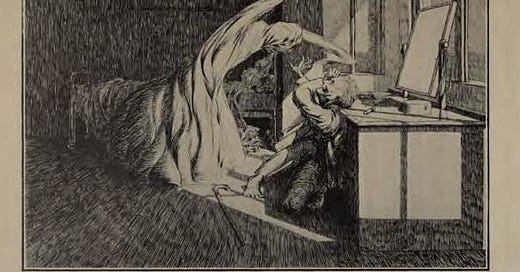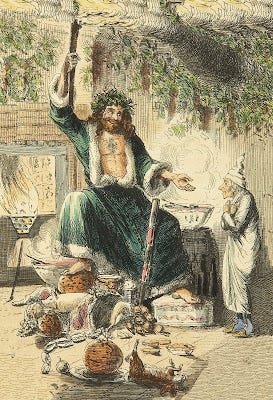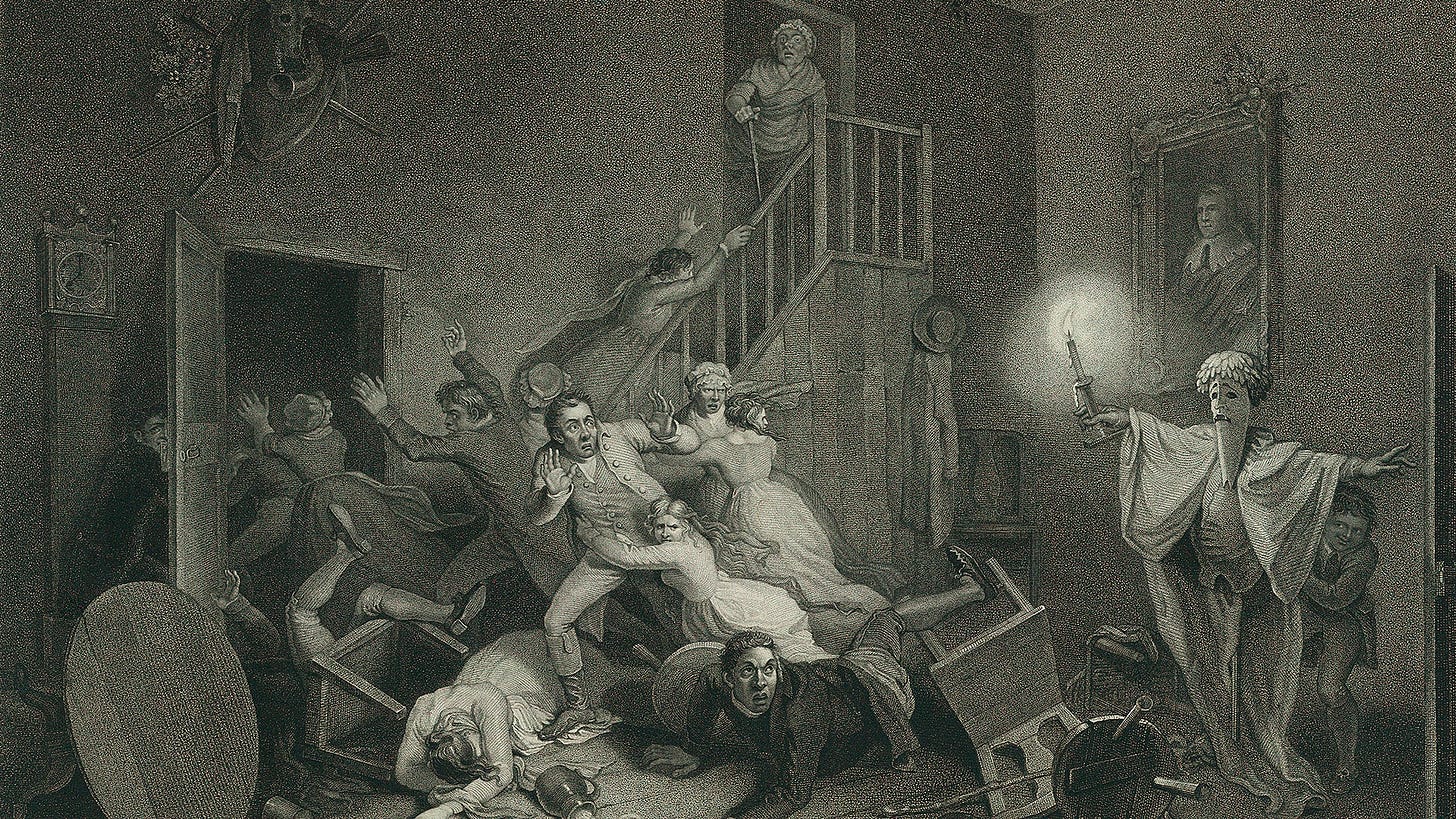Today, it’s difficult (if not impossible) to separate Christmas from commercialism. But it wasn’t always the case. Before Christmas came winter solstice celebrations (hello Saurnalia). Around 350 AD, Pope Julius I decided to complicate things and proclaimed December 25 as the birth of Christ. It caught on, and by the time the Middle Ages rolled around the Christian celebration had mostly supplanted pagan tradition. (Thankfully, there are many of those pagan traditions that survive to this day—some of which are in disguise—but that’s a topic for another day.) I could go on, but you can find plenty about the history of Christmas on the Internet, and we have other things to discuss. (GHOSTS!) However, if you are interested, you can find a nice little wrap up in “The History of Christmas” (History.com).
Certainly today, most of the churches revel in the celebrations as completely as do the corporate malls. That’s not a bad thing — it actually goes back to the sources of this kind of holiday, where we recognize that people have deep needs at this time of year to connect with that which is very important, but also to celebrate (Harry Smith, Christmas Unwrapped: The History of Christmas).
Yeah, yeah. But let’s get to the good stuff.
Although the Victorians didn’t create the ghost story, they embraced this type of tale as a significant part of the season. Unfortunately, this tradition fell out of favor over time (a win for the Puritans), something lamented by Colin Dickey in “A Plea to Resurrect the Christmas Tradition of Telling Ghost Stories” (Smithsonian Magazine). “For the last hundred years, Americans have kept ghosts in their place, letting them out only in October, in the run-up to our only real haunted holiday, Halloween,” Dickey reminds us. “But it wasn’t always this way, and it’s no coincidence that the most famous ghost story is a Christmas story—or, put another way, that the most famous Christmas story is a ghost story.” (You can read more about Dickens and his penchant for the ghostly tale at the LitHub article “Let’s Not Forget About Charles Dickens’ Other Christmas Ghost Stories” by Olivia Rutigliano.)
In 1843, Charles Dicken’s published A Christmas Carol. (I imagine you’ve heard of it.) The story took off, and before long the ghost story became an integral part of the Victorian Christmas tradition.
“Whenever five or six English-speaking people meet round a fire on Christmas Eve, they start telling each other ghost stories,” humorist Jerome K. Jerome wrote in his 1891 collection, Told After Supper. “Nothing satisfies us on Christmas Eve but to hear each other tell authentic anecdotes about spectres. It is a genial, festive season, and we love to muse upon graves, and dead bodies, and murders, and blood.”
Luckily, you can find a whole host of Christmas ghost stories available online. Or, if you prefer physical copies, Valencourt Books compiled and published four volumes for your reading pleasure: The Valancourt Book of Victorian Christmas Ghost Stories, edited and introduced by Tara Moore; The Valancourt Book of Victorian Christmas Ghost Stories, Volume Two, edited and introduced by Allen Grove; The Valancourt Book of Victorian Christmas Ghost Stories, Volume Three, edited and introduced by Simon Stern; and The Valancourt Book of Victorian Christmas Ghost Stories, Volume 4, edited and introduced by Christopher K. Philippo.
Pretty nifty covers, right?
However, if your bookcases are overflowing, or if you prefer to read online, I’ve collected a few classics for you to sample.
Christmas Ghost Stories in the Public Domain
“A Christmas Carol” by Charles Dickens (1843)
“The Old Nurse’s Story” by Elizabeth Gaskell (1852)
“Bring Me a light!” by Jane Margaret Hooper (1861)
“A Strange Christmas Game” by J. H. Riddell (1863)
“Oh, Whistle, and I'll Come to You, My Lad” M. R. James (1904)
“The Kit-Bag” by Algernon Blackwood (1908)
“Afterward: A Ghost Story for Christmas” by Edith Wharton (1910)
“Between the Lights” F. Benson (1912)
“Mr. Jones” by Edith Wharton (1928)
“The Tapestried Chamber, and Death of the Laird's Jock” by Sir Walter Scott (1828)
“Smee” by A. M. Burrage (1931)
For those of you who prefer a Christmas ghost story written in a more contemporary tone, The Guardian issued a series of Christmas ghost stories a few years ago with some fabulous little tales. As writers, it’s always a good idea to see what your contemporaries are up to. And this fun little selection is well worth checking out.
Contemporary Christmas Ghost Stories
“Stairs” by Penelope Lively
“Dark Christmas” by Jeanette Winterson
“Light And Space” by Ned Beauman
Sure, maybe it’s interesting, but you’ve seen it all before, right? Maybe. Maybe not.
A Christmas Challenge for Writers
If you’re following this Substack, chances are you’re a writer. So, let’s add a little twist to the subject shall we.
Here’s your challenge, if you choose to accept it:
Take one of the stories listed above, grab a line from the piece you selected and use it as the first line of your own ghostly tale. (This is a technique known as literary taxidermy. More on that in another post.) Another option is to scan the text and grab the first FIVE (or ten or fifteen) words that grab your attention. (Bibliomancy anyone?) Your task is to take those words and write a poem. The best part about both of these challenges is that your new piece of writing (story, drabble, poem, hybrid, memoir) doesn’t have to have any connection to the actual story you pull from. In fact, if you really want to switch it up grab selections from more than one story.
Seeing as the Victorians told their ghost stories on Christmas Eve, I’m taking direction from these ghosts of Christmas past and will be offering a short (very informal) gathering on Tuesday, December 24th at 11 am MST/ 1 pm EST/ 6 pm GMT. For our folks in Australia and New Zealand, you’re looking at Wednesday, December 25th at 5 am AEDT/ 7 am NZDT (sorry about that). I’ll be chatting about Victorian Christmas ghost stories followed by a reading a selection of the story I chose as inspiration (your guess is as good as mine), and then I’ll share the result. It should take about 30 minutes. However, if you choose to join me and have a sample of your own to share, I can extend the session to a full hour.
But it’s CHRISTMAS, Carina! Yeah, yeah. I know. Make up an excuse. Lock yourself in the closet or the cellar or some other uninhabited corner of your house and join me anyway. It’s only THIRTY MINUTES! An hour tops. And don’t you deserve a Christmas treat, too?
In the meantime, break out your pens, scribble in the margins of your grandmother’s fruitcake recipe, gather up scraps of wrapping paper—whatever you need to do—and get those ideas, fragments, bony beauties on the page. I, for one, am looking forward to seeing what skeletons you dig up. Bring a cocktail/mocktail and prepare for a ghostly good time!
EVENT LINK
Topic: Victorian Christmas Ghost Stories
Time: Dec 24, 2024 11:00 AM Mountain Time (US and Canada)
Join Zoom Meeting
https://us02web.zoom.us/j/82290562886?pwd=jtEibMTtvYvh3UyMOQNjRcPaMkAzaF.1
Meeting ID: 822 9056 2886
Passcode: 093686








